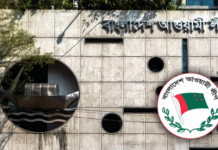
Bangladesh has moved three places up in the Global Human Development Index (HDI) and ranked 139th out of 188 nations.
The Human Development Report (HDR) 2016 was released at the NEC Conference Room of the Planning Commission on Wednesday.
The General Economics Division (GED) of the Planning Commission and United Nations Development Programme (UNDP) Bangladesh jointly organised the report unveiling in Bangladesh following the global launch in Stockholm, Sweden just two weeks ago.
Planning Minister AHM Mustafa Kamal was the chief guest at the report revelation ceremony.
Bangladesh had ranked 143rd out of 188 countries in the HDR report of 2015.
According to the report, which is published annually, Bangladesh was categorised as a “medium human development” country with the HDI value standing at 0.579 in 2015 increasing from 0.545 in 2010. The HDI value of Bangladesh was 0.468 in 2000 and 0.386 in 1990, clearly showing an upward trend in human development in the country.
The report also revealed a higher average annual HDI growth rate of Bangladesh (1.64 percent) during 1990-2015 compared to all other South Asian countries, including India (1.52 percent).
Bangladesh ranked 5th in South Asia, falling behind Sri Lanka (73), the Maldives (105), India (131) and Bhutan (132).
European country Norway (0.949) topped the list while Central African Republic (0.352) is in the bottom.
HDI was devised and launched in 1990 aiming to assess progress in three basic dimensions of human development: a long and healthy life, access to knowledge, and access to decent standard living.
“Bangladesh has shown tremendous progress in human development over the last two decades. Our average annual growth of HDI is better than that of any other countries in South Asia. Our social indicators show that we’re doing better in health, education, life expectancy at birth while our per capita income is increasing,” Planning Minister Kamal said in the programme.
According to HDR 2016, life expectancy at birth in Bangladesh stood at 72 years, expected years of schooling at 10.2 years, mean years of schooling 5.2 years, gross national income (GNI) per capita is $ 3,341.
State Minister for Foreign Affairs Md Shahriar Alam said, “Bangladesh has become a role model among the developing countries as its progress in recent years has impressed the world. We have to continue our development march for providing benefit to the people, especially the marginalised and excluded ones.”
Principal Coordinator for SDG Affairs at Prime Minister’s Office Abul Kalam Azad said, “Bangladesh has done tremendous jobs in achieving MDGs and we’re taking all-out preparations to successfully implement the Sustainable Development Goals (SDGs) also.”
Dr Selim Jahan, Director of Human Development Report Office, UNDP New York and lead author of HDR 2016, cautioned against paying too much attention to national averages, which often mask variations in people’s lives.
He made a presentation on key findings of the report and said, “In order to further advance, we need to examine more closely not just what has been achieved, but also who has been excluded and why. ”
“The HDR gives us an insight to the development progress, but also raises two main questions – who has been left out in the development process and how and why did that happen. The data and analysis provided in the Report are an important baseline for policy making, to ensure more inclusive human development,” said Sudipto Mukerjee, UNDP Bangladesh Country Director.
Among others, former caretaker government adviser Rasheda K Choudhury spoke on the occasion.
As worldwide almost 1.5 billion people still live in multidimensional poverty– reflecting acute deprivations in health, education and standards of living, the report stressed the importance of the 2030 Agenda for Sustainable Development (SDGs) and called for far greater attention for empowering the most marginalized in society.
Source: The Daily Ittefaq









